时间复杂度¶
统计算法运行时间¶
运行时间能够直观且准确地体现出算法的效率水平。如果我们想要 准确预估一段代码的运行时间 ,该如何做呢?
- 首先需要 确定运行平台 ,包括硬件配置、编程语言、系统环境等,这些都会影响到代码的运行效率。
- 评估 各种计算操作的所需运行时间 ,例如加法操作
+需要 1 ns ,乘法操作*需要 10 ns ,打印操作需要 5 ns 等。 - 根据代码 统计所有计算操作的数量 ,并将所有操作的执行时间求和,即可得到运行时间。
例如以下代码,输入数据大小为 \(n\) ,根据以上方法,可以得到算法运行时间为 \(6n + 12\) ns 。
但实际上, 统计算法的运行时间既不合理也不现实。 首先,我们不希望预估时间和运行平台绑定,毕竟算法需要跑在各式各样的平台之上。其次,我们很难获知每一种操作的运行时间,这为预估过程带来了极大的难度。
统计时间增长趋势¶
「时间复杂度分析」采取了不同的做法,其统计的不是算法运行时间,而是 算法运行时间随着数据量变大时的增长趋势 。
“时间增长趋势” 这个概念比较抽象,我们借助一个例子来理解。设输入数据大小为 \(n\) ,给定三个算法 A , B , C 。
- 算法
A只有 \(1\) 个打印操作,算法运行时间不随着 \(n\) 增大而增长。我们称此算法的时间复杂度为「常数阶」。 - 算法
B中的打印操作需要循环 \(n\) 次,算法运行时间随着 \(n\) 增大成线性增长。此算法的时间复杂度被称为「线性阶」。 - 算法
C中的打印操作需要循环 \(1000000\) 次,但运行时间仍与输入数据大小 \(n\) 无关。因此C的时间复杂度和A相同,仍为「常数阶」。

Fig. 算法 A, B, C 的时间增长趋势
相比直接统计算法运行时间,时间复杂度分析的做法有什么好处呢?以及有什么不足?
时间复杂度可以有效评估算法效率。 算法 B 运行时间的增长是线性的,在 \(n > 1\) 时慢于算法 A ,在 \(n > 1000000\) 时慢于算法 C 。实质上,只要输入数据大小 \(n\) 足够大,复杂度为「常数阶」的算法一定优于「线性阶」的算法,这也正是时间增长趋势的含义。
时间复杂度分析将统计「计算操作的运行时间」简化为统计「计算操作的数量」。 这是因为,无论是运行平台、还是计算操作类型,都与算法运行时间的增长趋势无关。因此,我们可以简单地将所有计算操作的执行时间统一看作是相同的 “单位时间” 。
时间复杂度也存在一定的局限性。 比如,虽然算法 A 和 C 的时间复杂度相同,但是实际的运行时间有非常大的差别。再比如,虽然算法 B 比 C 的时间复杂度要更高,但在输入数据大小 \(n\) 比较小时,算法 B 是要明显优于算法 C 的。即使存在这些问题,计算复杂度仍然是评判算法效率的最有效、最常用方法。
函数渐近上界¶
设算法「计算操作数量」为 \(T(n)\) ,其是一个关于输入数据大小 \(n\) 的函数。例如,以下算法的操作数量为
\(T(n)\) 是个一次函数,说明时间增长趋势是线性的,因此易得时间复杂度是线性阶。
我们将线性阶的时间复杂度记为 \(O(n)\) ,这个数学符号被称为「大 \(O\) 记号 Big-\(O\) Notation」,代表函数 \(T(n)\) 的「渐近上界 asymptotic upper bound」。
我们要推算时间复杂度,本质上是在计算「操作数量函数 \(T(n)\) 」的渐近上界。下面我们先来看看函数渐近上界的数学定义。
函数渐近上界
若存在正实数 \(c\) 和实数 \(n_0\) ,使得对于所有的 \(n > n_0\) ,均有 $$ T(n) \leq c \cdot f(n) $$ 则可认为 \(f(n)\) 给出了 \(T(n)\) 的一个渐近上界,记为 $$ T(n) = O(f(n)) $$
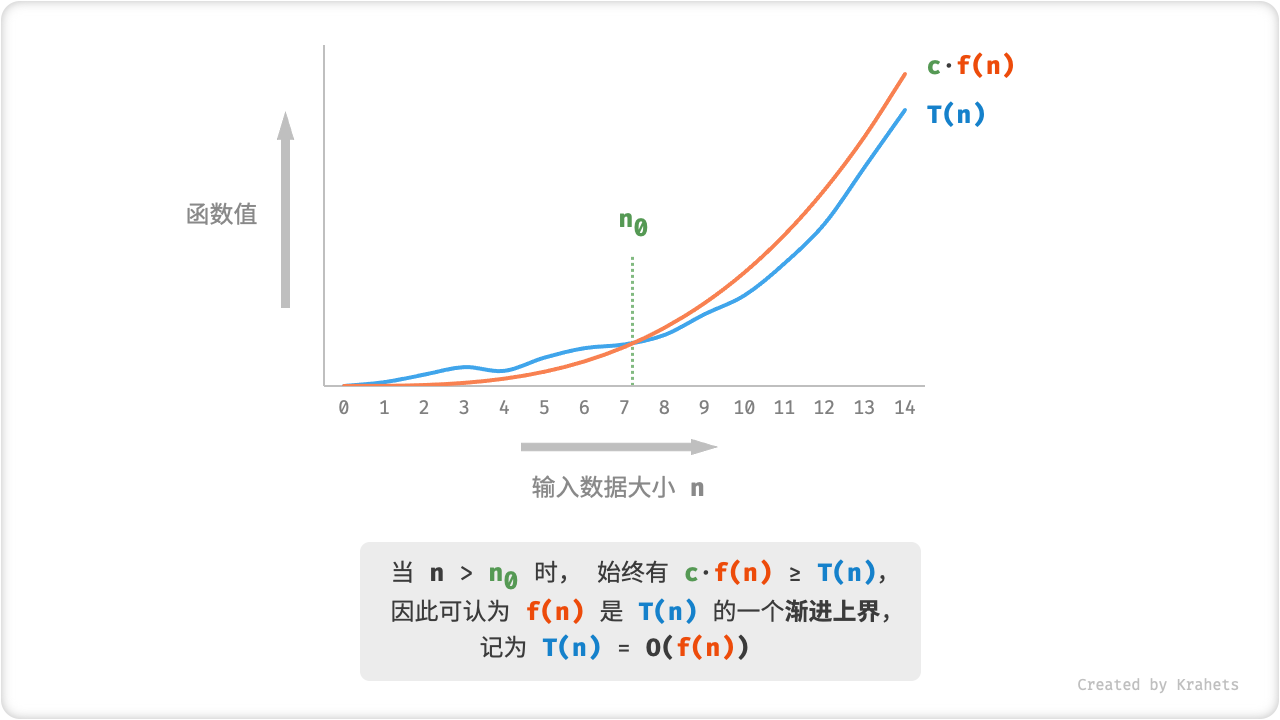
Fig. 函数的渐近上界
本质上看,计算渐近上界就是在找一个函数 \(f(n)\) ,使得在 \(n\) 趋向于无穷大时,\(T(n)\) 和 \(f(n)\) 处于相同的增长级别(仅相差一个常数项 \(c\) 的倍数)。
Tip
渐近上界的数学味儿有点重,如果你感觉没有完全理解,无需担心,因为在实际使用中我们只需要会推算即可,数学意义可以慢慢领悟。
推算方法¶
推算出 \(f(n)\) 后,我们就得到时间复杂度 \(O(f(n))\) 。那么,如何来确定渐近上界 \(f(n)\) 呢?总体分为两步,首先「统计操作数量」,然后「判断渐近上界」。
1. 统计操作数量¶
对着代码,从上到下一行一行地计数即可。然而,由于上述 \(c \cdot f(n)\) 中的常数项 \(c\) 可以取任意大小,因此操作数量 \(T(n)\) 中的各种系数、常数项都可以被忽略。根据此原则,可以总结出以下计数偷懒技巧:
- 跳过数量与 \(n\) 无关的操作。 因为他们都是 \(T(n)\) 中的常数项,对时间复杂度不产生影响。
- 省略所有系数。 例如,循环 \(2n\) 次、\(5n + 1\) 次、……,都可以化简记为 \(n\) 次,因为 \(n\) 前面的系数对时间复杂度也不产生影响。
- 循环嵌套时使用乘法。 总操作数量等于外层循环和内层循环操作数量之积,每一层循环依然可以分别套用上述
1.和2.技巧。
根据以下示例,使用上述技巧前、后的统计结果分别为
最终,两者都能推出相同的时间复杂度结果,即 \(O(n^2)\) 。
2. 判断渐近上界¶
时间复杂度由多项式 \(T(n)\) 中最高阶的项来决定。这是因为在 \(n\) 趋于无穷大时,最高阶的项将处于主导作用,其它项的影响都可以被忽略。
以下表格给出了一些例子,其中有一些夸张的值,是想要向大家强调 系数无法撼动阶数 这一结论。在 \(n\) 趋于无穷大时,这些常数都是 “浮云” 。
| 操作数量 \(T(n)\) | 时间复杂度 \(O(f(n))\) |
|---|---|
| \(100000\) | \(O(1)\) |
| \(3n + 2\) | \(O(n)\) |
| \(2n^2 + 3n + 2\) | \(O(n^2)\) |
| \(n^3 + 10000n^2\) | \(O(n^3)\) |
| \(2^n + 10000n^{10000}\) | \(O(2^n)\) |
常见类型¶
设输入数据大小为 \(n\) ,常见的时间复杂度类型有(从低到高排列)
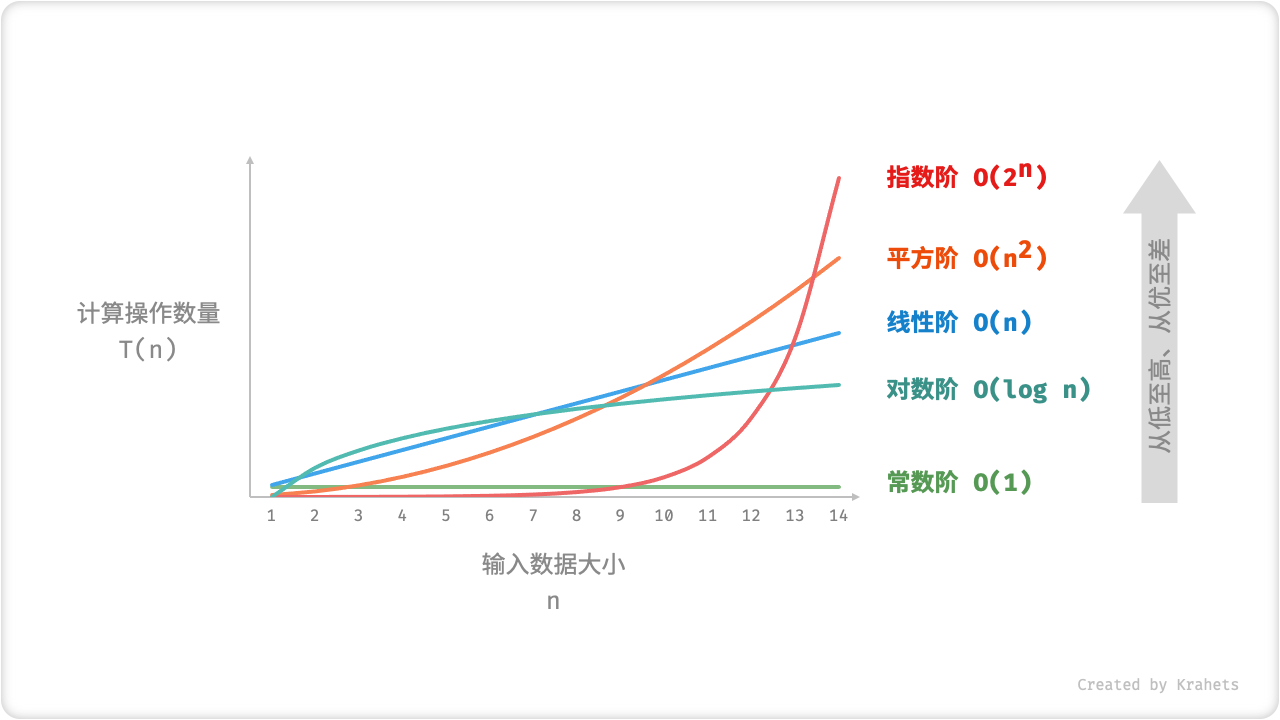
Fig. 时间复杂度的常见类型
Tip
部分示例代码需要一些前置知识,包括数组、递归算法等。如果遇到看不懂的地方无需担心,可以在学习完后面章节后再来复习,现阶段先聚焦在理解时间复杂度含义和推算方法上。
常数阶 \(O(1)\)¶
常数阶的操作数量与输入数据大小 \(n\) 无关,即不随着 \(n\) 的变化而变化。
对于以下算法,无论操作数量 size 有多大,只要与数据大小 \(n\) 无关,时间复杂度就仍为 \(O(1)\) 。
线性阶 \(O(n)\)¶
线性阶的操作数量相对输入数据大小成线性级别增长。线性阶常出现于单层循环。
「遍历数组」和「遍历链表」等操作,时间复杂度都为 \(O(n)\) ,其中 \(n\) 为数组或链表的长度。
Tip
数据大小 \(n\) 是根据输入数据的类型来确定的。 比如,在上述示例中,我们直接将 \(n\) 看作输入数据大小;以下遍历数组示例中,数据大小 \(n\) 为数组的长度。
平方阶 \(O(n^2)\)¶
平方阶的操作数量相对输入数据大小成平方级别增长。平方阶常出现于嵌套循环,外层循环和内层循环都为 \(O(n)\) ,总体为 \(O(n^2)\) 。
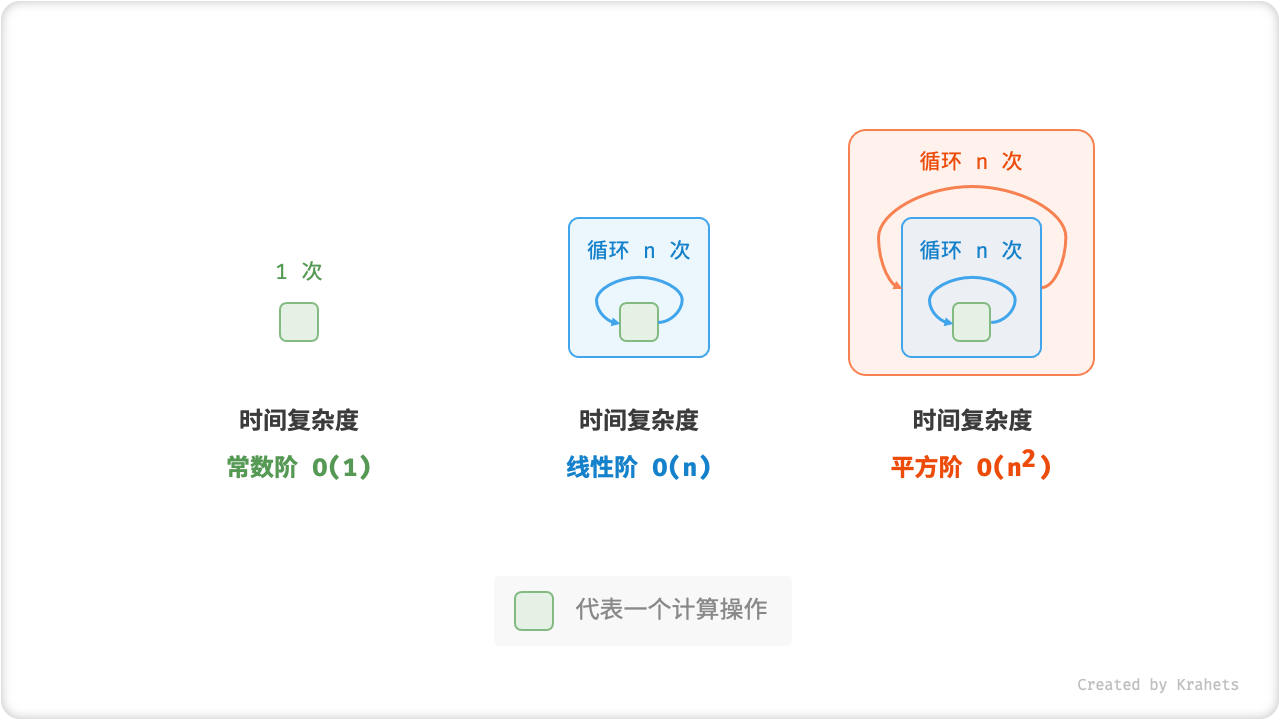
Fig. 常数阶、线性阶、平方阶的时间复杂度
以「冒泡排序」为例,外层循环 \(n - 1\) 次,内层循环 \(n-1, n-2, \cdots, 2, 1\) 次,平均为 \(\frac{n}{2}\) 次,因此时间复杂度为 \(O(n^2)\) 。
/* 平方阶(冒泡排序) */
int bubbleSort(int[] nums) {
int count = 0; // 计数器
// 外循环:待排序元素数量为 n-1, n-2, ..., 1
for (int i = nums.length - 1; i > 0; i--) {
// 内循环:冒泡操作
for (int j = 0; j < i; j++) {
if (nums[j] > nums[j + 1]) {
// 交换 nums[j] 与 nums[j + 1]
int tmp = nums[j];
nums[j] = nums[j + 1];
nums[j + 1] = tmp;
count += 3; // 元素交换包含 3 个单元操作
}
}
}
return count;
}
/* 平方阶(冒泡排序) */
int bubbleSort(vector<int>& nums) {
int count = 0; // 计数器
// 外循环:待排序元素数量为 n-1, n-2, ..., 1
for (int i = nums.size() - 1; i > 0; i--) {
// 内循环:冒泡操作
for (int j = 0; j < i; j++) {
if (nums[j] > nums[j + 1]) {
// 交换 nums[j] 与 nums[j + 1]
int tmp = nums[j];
nums[j] = nums[j + 1];
nums[j + 1] = tmp;
count += 3; // 元素交换包含 3 个单元操作
}
}
}
return count;
}
""" 平方阶(冒泡排序)"""
def bubble_sort(nums):
count = 0 # 计数器
# 外循环:待排序元素数量为 n-1, n-2, ..., 1
for i in range(len(nums) - 1, 0, -1):
# 内循环:冒泡操作
for j in range(i):
if nums[j] > nums[j + 1]:
# 交换 nums[j] 与 nums[j + 1]
tmp = nums[j]
nums[j] = nums[j + 1]
nums[j + 1] = tmp
count += 3 # 元素交换包含 3 个单元操作
return count
/* 平方阶(冒泡排序) */
func bubbleSort(nums []int) int {
count := 0 // 计数器
// 外循环:待排序元素数量为 n-1, n-2, ..., 1
for i := len(nums) - 1; i > 0; i-- {
// 内循环:冒泡操作
for j := 0; j < i; j++ {
if nums[j] > nums[j+1] {
// 交换 nums[j] 与 nums[j + 1]
tmp := nums[j]
nums[j] = nums[j+1]
nums[j+1] = tmp
count += 3 // 元素交换包含 3 个单元操作
}
}
}
return count
}
指数阶 \(O(2^n)\)¶
Note
生物学科中的 “细胞分裂” 即是指数阶增长:初始状态为 \(1\) 个细胞,分裂一轮后为 \(2\) 个,分裂两轮后为 \(4\) 个,……,分裂 \(n\) 轮后有 \(2^n\) 个细胞。
指数阶增长得非常快,在实际应用中一般是不能被接受的。若一个问题使用「暴力枚举」求解的时间复杂度是 \(O(2^n)\) ,那么一般都需要使用「动态规划」或「贪心算法」等算法来求解。
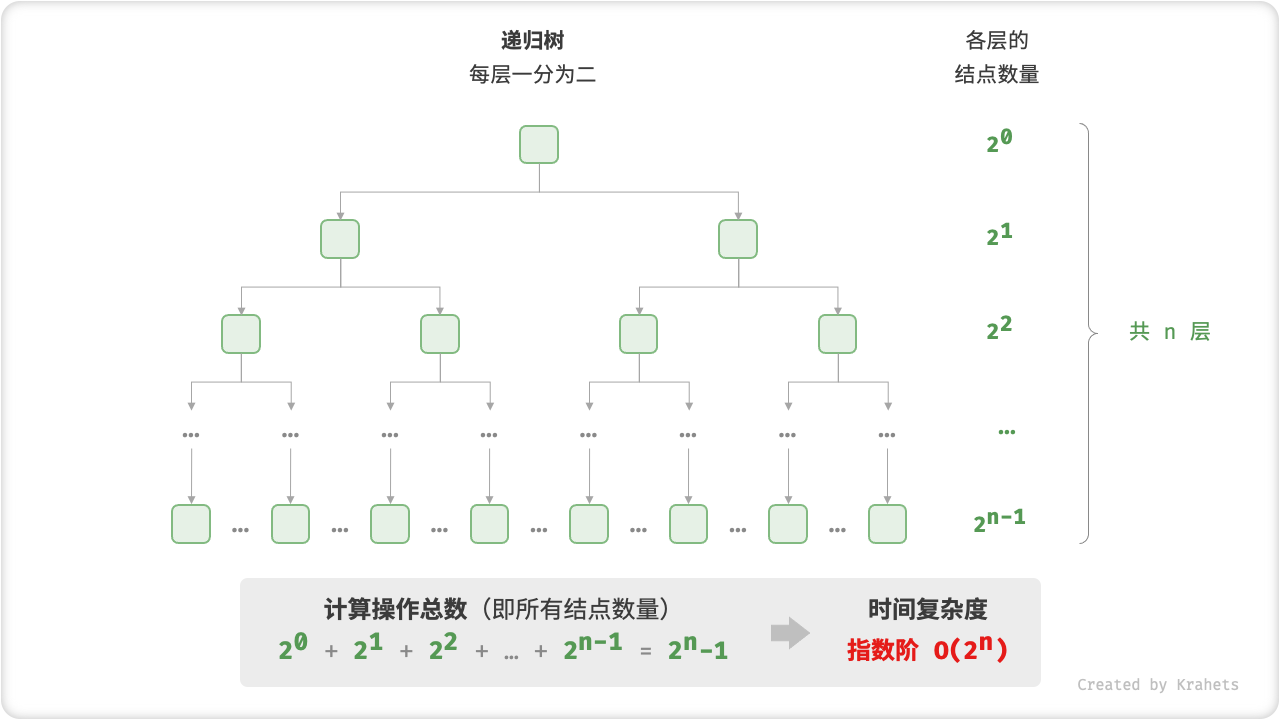
Fig. 指数阶的时间复杂度
在实际算法中,指数阶常出现于递归函数。例如以下代码,不断地一分为二,分裂 \(n\) 次后停止。
对数阶 \(O(\log n)\)¶
对数阶与指数阶正好相反,后者反映 “每轮增加到两倍的情况” ,而前者反映 “每轮缩减到一半的情况” 。对数阶仅次于常数阶,时间增长的很慢,是理想的时间复杂度。
对数阶常出现于「二分查找」和「分治算法」中,体现 “一分为多” 、“化繁为简” 的算法思想。
设输入数据大小为 \(n\) ,由于每轮缩减到一半,因此循环次数是 \(\log_2 n\) ,即 \(2^n\) 的反函数。

Fig. 对数阶的时间复杂度
与指数阶类似,对数阶也常出现于递归函数。以下代码形成了一个高度为 \(\log_2 n\) 的递归树。
线性对数阶 \(O(n \log n)\)¶
线性对数阶常出现于嵌套循环中,两层循环的时间复杂度分别为 \(O(\log n)\) 和 \(O(n)\) 。
主流排序算法的时间复杂度都是 \(O(n \log n )\) ,例如快速排序、归并排序、堆排序等。
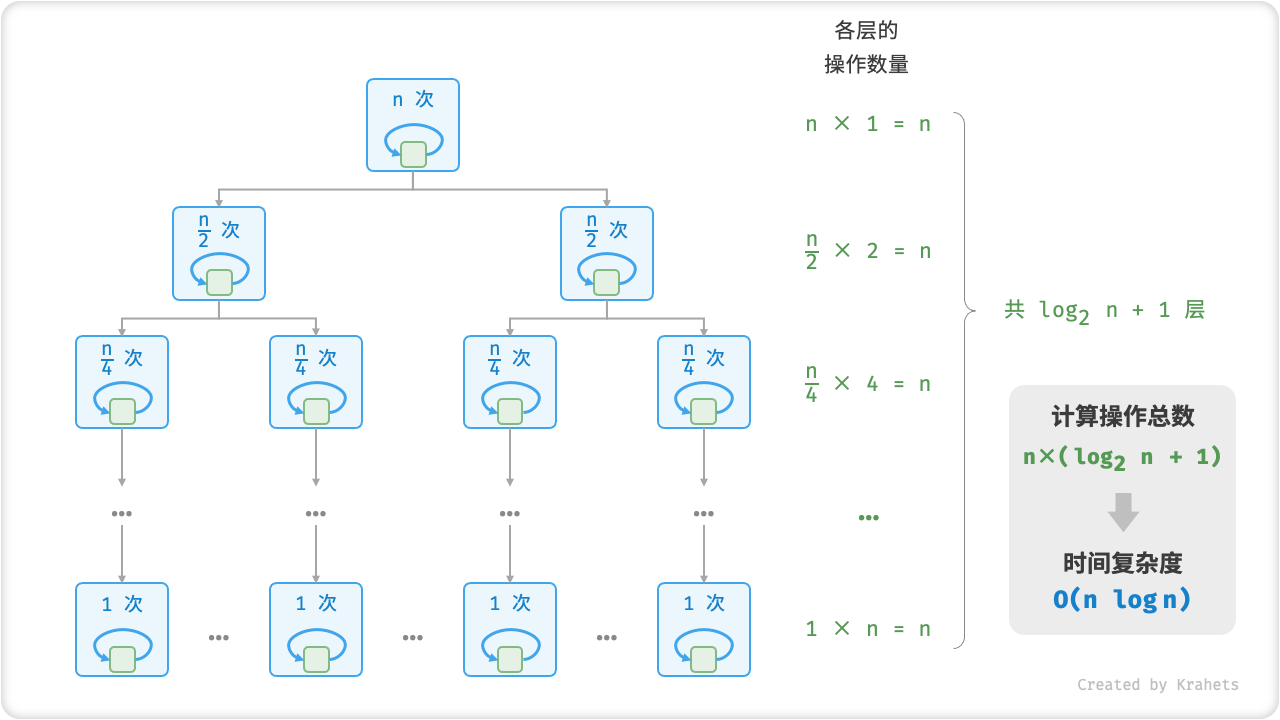
Fig. 线性对数阶的时间复杂度
阶乘阶 \(O(n!)\)¶
阶乘阶对应数学上的「全排列」。即给定 \(n\) 个互不重复的元素,求其所有可能的排列方案,则方案数量为
阶乘常使用递归实现。例如以下代码,第一层分裂出 \(n\) 个,第二层分裂出 \(n - 1\) 个,…… ,直至到第 \(n\) 层时终止分裂。
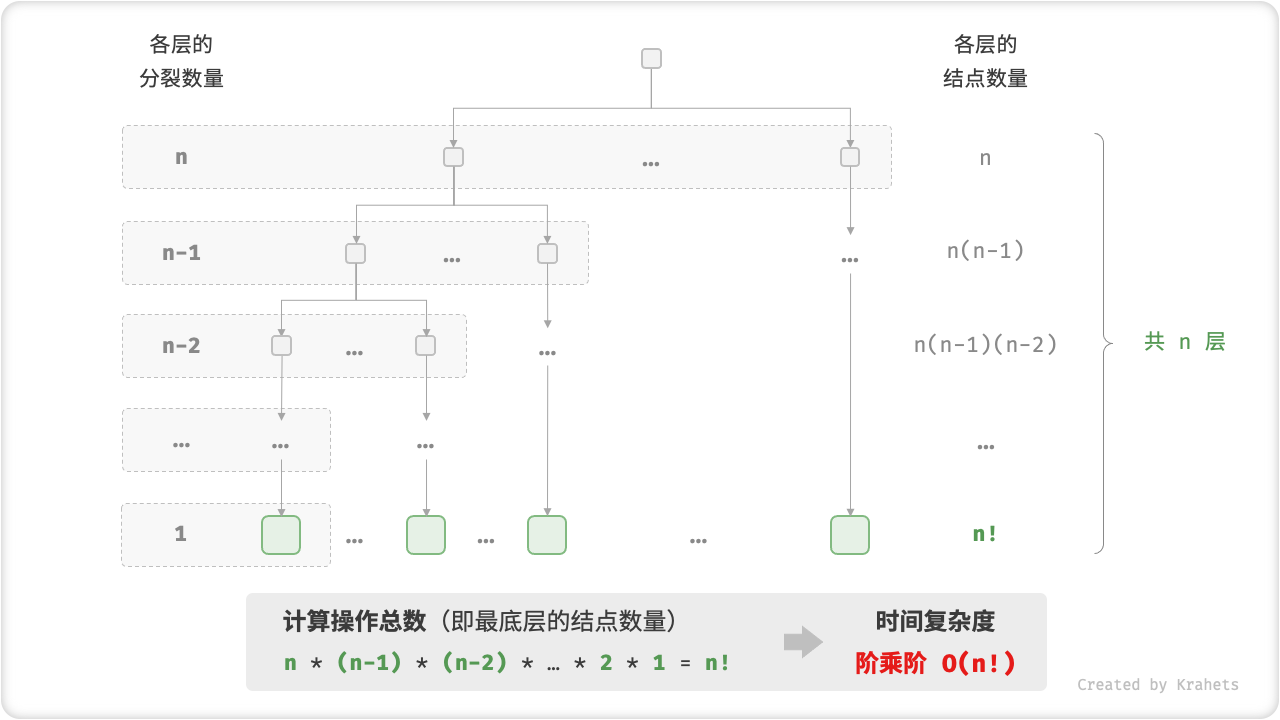
Fig. 阶乘阶的时间复杂度
最差、最佳、平均时间复杂度¶
某些算法的时间复杂度不是恒定的,而是与输入数据的分布有关。 举一个例子,输入一个长度为 \(n\) 数组 nums ,其中 nums 由从 \(1\) 至 \(n\) 的数字组成,但元素顺序是随机打乱的;算法的任务是返回元素 \(1\) 的索引。我们可以得出以下结论:
- 当
nums = [?, ?, ..., 1],即当末尾元素是 \(1\) 时,则需完整遍历数组,此时达到 最差时间复杂度 \(O(n)\) ; - 当
nums = [1, ?, ?, ...],即当首个数字为 \(1\) 时,无论数组多长都不需要继续遍历,此时达到 最佳时间复杂度 \(\Omega(1)\) ;
「函数渐近上界」使用大 \(O\) 记号表示,代表「最差时间复杂度」。与之对应,「函数渐近下界」用 \(\Omega\) 记号(Omega Notation)来表示,代表「最佳时间复杂度」。
public class worst_best_time_complexity {
/* 生成一个数组,元素为 { 1, 2, ..., n },顺序被打乱 */
static int[] randomNumbers(int n) {
Integer[] nums = new Integer[n];
// 生成数组 nums = { 1, 2, 3, ..., n }
for (int i = 0; i < n; i++) {
nums[i] = i + 1;
}
// 随机打乱数组元素
Collections.shuffle(Arrays.asList(nums));
// Integer[] -> int[]
int[] res = new int[n];
for (int i = 0; i < n; i++) {
res[i] = nums[i];
}
return res;
}
/* 查找数组 nums 中数字 1 所在索引 */
static int findOne(int[] nums) {
for (int i = 0; i < nums.length; i++) {
if (nums[i] == 1)
return i;
}
return -1;
}
/* Driver Code */
public static void main(String[] args) {
for (int i = 0; i < 10; i++) {
int n = 100;
int[] nums = randomNumbers(n);
int index = findOne(nums);
System.out.println("打乱后的数组为 " + Arrays.toString(nums));
System.out.println("数字 1 的索引为 " + index);
}
}
}
/* 生成一个数组,元素为 { 1, 2, ..., n },顺序被打乱 */
vector<int> randomNumbers(int n) {
vector<int> nums(n);
// 生成数组 nums = { 1, 2, 3, ..., n }
for (int i = 0; i < n; i++) {
nums[i] = i + 1;
}
// 使用系统时间生成随机种子
unsigned seed = chrono::system_clock::now().time_since_epoch().count();
// 随机打乱数组元素
shuffle(nums.begin(), nums.end(), default_random_engine(seed));
return nums;
}
/* 查找数组 nums 中数字 1 所在索引 */
int findOne(vector<int>& nums) {
for (int i = 0; i < nums.size(); i++) {
if (nums[i] == 1)
return i;
}
return -1;
}
/* Driver Code */
int main() {
for (int i = 0; i < 1000; i++) {
int n = 100;
vector<int> nums = randomNumbers(n);
int index = findOne(nums);
cout << "\n数组 [ 1, 2, ..., n ] 被打乱后 = ";
PrintUtil::printVector(nums);
cout << "数字 1 的索引为 " << index << endl;
}
return 0;
}
""" 生成一个数组,元素为: 1, 2, ..., n ,顺序被打乱 """
def random_numbers(n):
# 生成数组 nums =: 1, 2, 3, ..., n
nums = [i for i in range(1, n + 1)]
# 随机打乱数组元素
random.shuffle(nums)
return nums
""" 查找数组 nums 中数字 1 所在索引 """
def find_one(nums):
for i in range(len(nums)):
if nums[i] == 1:
return i
return -1
""" Driver Code """
if __name__ == "__main__":
for i in range(10):
n = 100
nums = random_numbers(n)
index = find_one(nums)
print("\n数组 [ 1, 2, ..., n ] 被打乱后 =", nums)
print("数字 1 的索引为", index)
/* 生成一个数组,元素为 { 1, 2, ..., n },顺序被打乱 */
func randomNumbers(n int) []int {
nums := make([]int, n)
// 生成数组 nums = { 1, 2, 3, ..., n }
for i := 0; i < n; i++ {
nums[i] = i + 1
}
// 随机打乱数组元素
rand.Shuffle(len(nums), func(i, j int) {
nums[i], nums[j] = nums[j], nums[i]
})
return nums
}
/* 查找数组 nums 中数字 1 所在索引 */
func findOne(nums []int) int {
for i := 0; i < len(nums); i++ {
if nums[i] == 1 {
return i
}
}
return -1
}
/* Driver Code */
func main() {
for i := 0; i < 10; i++ {
n := 100
nums := randomNumbers(n)
index := findOne(nums)
fmt.Println("\n数组 [ 1, 2, ..., n ] 被打乱后 =", nums)
fmt.Println("数字 1 的索引为", index)
}
}
Tip
我们在实际应用中很少使用「最佳时间复杂度」,因为往往只有很小概率下才能达到,会带来一定的误导性。反之,「最差时间复杂度」最为实用,因为它给出了一个 “效率安全值” ,让我们可以放心地使用算法。
从上述示例可以看出,最差或最佳时间复杂度只出现在 “特殊分布的数据” 中,这些情况的出现概率往往很小,因此并不能最真实地反映算法运行效率。相对地,「平均时间复杂度」可以体现算法在随机输入数据下的运行效率,用 \(\Theta\) 记号(Theta Notation)来表示。
对于部分算法,我们可以简单地推算出随机数据分布下的平均情况。比如上述示例,由于输入数组是被打乱的,因此元素 \(1\) 出现在任意索引的概率都是相等的,那么算法的平均循环次数则是数组长度的一半 \(\frac{n}{2}\) ,平均时间复杂度为 \(\Theta(\frac{n}{2}) = \Theta(n)\) 。
但在实际应用中,尤其是较为复杂的算法,计算平均时间复杂度比较困难,因为很难简便地分析出在数据分布下的整体数学期望。这种情况下,我们一般使用最差时间复杂度来作为算法效率的评判标准。
为什么很少看到 \(\Theta\) 符号?
实际中我们经常使用「大 \(O\) 符号」来表示「平均复杂度」,这样严格意义上来说是不规范的。这可能是因为 \(O\) 符号实在是太朗朗上口了。如果在本书和其他资料中看到类似 平均时间复杂度 \(O(n)\) 的表述,请你直接理解为 \(\Theta(n)\) 即可。